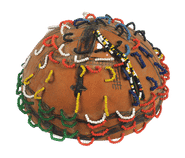Presented by Museum of the Peace Corps Experience and American University Museum
Elizabeth Bako, Sara Madjingaye, c. 1969
Sarh (formerly Ft. Archambault), Moyen-Chari, Chad
Gourd, beading, pyro-engraving,
3 1/4 x 6 1/2 x 6 1/2 in.
Collection, Museum of the Peace Corps Experience
Gift of Marla Bush, Chad, Ft. Lamy 1968–70

I was probably one of the few Peace Corps volunteers who ever requested Chad. Although I had lived in North Africa, had a master’s degree in African studies, and traveled extensively on the continent, I knew little about Chad. I just knew I wanted to go there.
In one of my letters home, I quoted a foreigner working in Chad who said, “Chad does not have anything of artistic interest.” That person must have overlooked the ubiquitous, humble calabash.
A special 1970 edition of Jeune Afrique featuring Chad noted that calabashes were a major Chadian art form. Multipurpose vessels, they are used for storage, food preparation, and serving; as ladles, drinking vessels, containers for milk and other products—even as parts of musical instruments. They are decorated by women in a myriad of tribal styles and techniques and are a source of pride and wealth.
I was immediately struck by their presence and beauty. From day one I started collecting and displaying them in my home. I ate out of calabashes in the homes of Chadian friends and used them as serving dishes in my home. My appreciation must have been noticed, as Chadian friends and students chose calabashes as gifts. Others I purchased in homes, from market women, or in the little tourist market.
One special calabash came from a visit to Ft. Archambault where I stayed with a Peace Corps couple. A couple of students of a volunteer friend came to visit and one of them, Elizabeth Bako, gifted me this gourd. It has traditional pyro-engraved patterns, but it was personalized by Elizabeth with bead stitching and beaded cords for carrying. By the end of my time in Chad, I came home with a large collection of calabashes. Some of them now reside in the permanent collection of the Baltimore Museum of Art.
The Committee for a Museum of the Peace Corps Experience is a 501(c)(3) private nonprofit organization. Tax ID: EIN # 93-1289853
The Museum is not affiliated with the U.S. Peace Corps and not acting on behalf of the U.S. Peace Corps.
Museum of the Peace Corps Experience © 2024. All Rights Reserved.